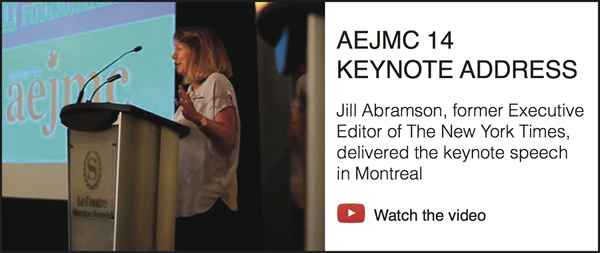CONTACT: PAULA POINDEXTER, Texas-Austin, 2013-14 President of AEJMC • August 27, 2014
As the shooting death of an unarmed black teenager by a white police officer moved from a crime scene in the middle of a Ferguson, Mo., street to a secret grand jury comprised of nine whites and three blacks who will determine if the police officer will stand trial, the Association for Education in Journalism and Mass Communication (AEJMC) commends the press for performing its watchdog role, condemns the Ferguson, Mo., police for abusing the press’ First Amendment freedoms and reminds everyone, regardless of color, education, age, gender, status or political affiliation, that the First Amendment safeguards the press’ right to report and citizens’ right to access news they should know.
The fatal shooting of 18-year-old Michael Brown by Officer Darren Wilson was one of the biggest stories of summer 2014, certainly in terms of sustained 24/7 news coverage and social media postings. Those who followed the news witnessed events as they unfolded, from images of Brown’s body lying for hours in the street to peaceful protests that erupted into violence and vandalism, to local police wearing gas masks and pointing assault weapons as they sat atop armored vehicles that one might expect to see in news reports about war-torn areas—not middle-America suburbia. And, among the many disturbing words and images from Ferguson were reports of police arresting, confining and threatening journalists for doing their jobs. After the first arrests of journalists from the Washington Post and Huffington Post, CNN’s media critic and host of “Reliable Sources” reported that Ferguson police had arrested 11 journalists.
When police officers in Ferguson arrested journalists, they were not just interfering with journalists’ First Amendment rights, they were also interfering with what the authors of The Elements of Journalism described as information citizens need to be “free and self-governing.”
Only because of journalists could the tragic events in a poor and mostly African American St. Louis suburb, population 21,000, command the attention of the nation, the president, and the attorney general. That’s the power of the First Amendment and why it should never be obstructed by law enforcement or other government officials. The First Amendment both protects journalists’ freedom to report and makes it possible for citizens to have access to news from multiple sources. Even when the news is about tragic events like the shooting death of 18-year-old Michael Brown in Ferguson, Mo., the news is ultimately empowering because it is information citizens living in a democracy need to be “free and self-governing.”
For more information regarding this AEJMC Presidential Statement, please contact Paula Poindexter, President of AEJMC, at paula.poindexter@austin.utexas.edu.
AEJMC (The Association for Education in Journalism and Mass Communication) is a nonprofit, educational association of journalism and mass communication educators, students and media professionals. The Association’s mission is to advance education, foster scholarly research, cultivate better professional practice and promote the free flow of communication. To find out more about AEJMC, visit www.AEJMC.org.

